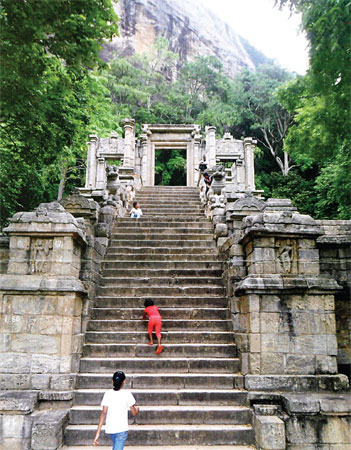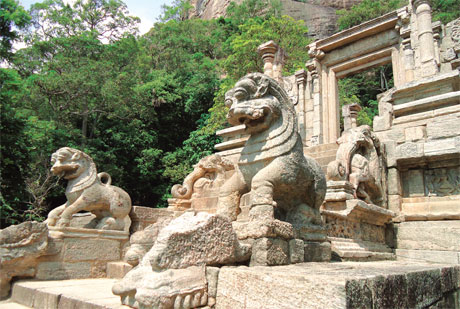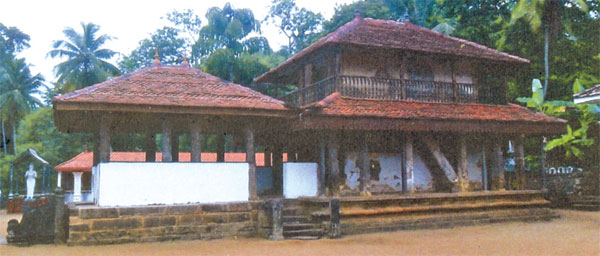|
Winner:
The glory of Ethugalpura
We carry below a well-written essay chronicling
a part of Sri Lanka’s history. The writer has been selected as a winner
in our weekly essay competition
|

Entrance to the Temple of the Tooth Relic at Yapahuwa |
Ethugalpura, commonly known as Kurunegala, is one of the important
districts in Sri Lanka, as three ancient kingdoms were located there.
They are Dambadeniya, Yapahuwa and Panduwasnuwara.
The historical Dambadeniya kingdom is considered the third kingdom of
Sri Lanka. It was ruled by four Kings named Vijayabahu III,
Parakramabahu II, Vijayabahu IV and Buwanekabahu I. According to the
great chronicles, the Sacred Tooth Relic was kept at a temple called
Vijayasundararama. The temple is still in its majestic splendour.
Earlier it was a three-storeyed building but due to renovation during
the Kandyan era it is now a two-storeyed building. The building which
was used to exhibit the Sacred Tooth Relic at the temple has been turned
into a Vatadageya which has a stupa inside.
The royal palace was located on a rock. There are about 260 steps
leading to the palace. In the ancient days, there was a stone trap in
the middle of the staircase. The width of the staircase is extremely
small. At certain points only a single person can climb, at a time.
Archaeological excavations have been carried out by the
Archaeological Department. The film Siri Parakum was filmed there.
Belumgala is another interesting spot hidden in the thick forest.
After climbing a couple of metres, you can reach it and a vast area can
be seen. It was used to spotting invaders by the King and there is
evidence that security huts were constructed on the Belumgala. It is
said that a tunnel is also there leading from the rock to
Vijayasundararama.
|

Stone carved lion on palace steps |
According to the great chronicles, Yapahuwa is identified as the
fourth kingdom of ancient Sri Lanka. Buwanekabahu I and Parakramabahu
III were the great Kings in this era. They also built their kingdoms on
rocks to prevent foreign invasion. There were four entrances facing all
four directions. Now the ruins of the kingdoms are still visible. The
fortress built by the local administrator Subha is considered a
marvellous creation. It was built by him to keep the Sacred Tooth Relic.
The magnificent stone carvings give us a clear indication about the
ancient glory of the place.
There are four sets of stairs leading to the top. The first two sets
of stairs are not difficult to climb. However, the third and fourth sets
are difficult to climb. The angle is steep. The width of the stairs is
also small which amounts to a hand span.
The construction of stairs delay people reaching the top and the sole
idea of this was to protect the Sacred Tooth Relic which was kept at the
top because it was said that the person who owns the Sacred Tooth Relic
was considered the king of Sri Lanka.
|

Temple of the Tooth Relic at Dambadeniya |
There are many stone carvings depicting women, drummers and dancers.
There are two lion figures on either side of the staircase. The face
resembles that of a dragon and the rest is of a lion. The world famous
lion figures can be seen in the old ten-rupee note. There is a tunnel
that leads from the fortress to a far away mountain. There are lots of
caves which were occupied by Bhikkhus in the early days.The other
interesting kingdom found in the Kurunegala district is Panduwasnuwara.
It was the kingdom of King Panduwasudeva and the kingdom covers an area
of about 20 acres. There are many ruins in this place.
The palace was surrounded by ditches and walls. The famous Ektamgeya
(the house which was built on a single pillar) was also located
close-by. This was built for Chithra, the daughter of King Panduwasudeva.
When Chithra was a young princess, soothsayers said that if she got a
son he would kill his uncles and become king. Brothers of the princess
built the Ektamgeya to prevent her meeting any males. However, she gave
birth to a son and exchanged him with a baby girl who was born on the
same day.
The baby boy lived in a remote village called Doramandalawa, and true
to prediction, he became the king of Panduwasnuwara and was named
Pandukabhaya. The ruins of the Ektamgeya are still to be seen and some
say that this is the place where King Parakramabahu I was sworn in as
the leader of seven countries after a war.
Ethugalpura contributes towards our proud history.
Nithuli Subasinghe, Grade 8B, Vidura College,
Colombo. |

